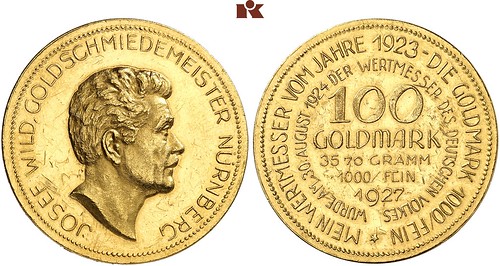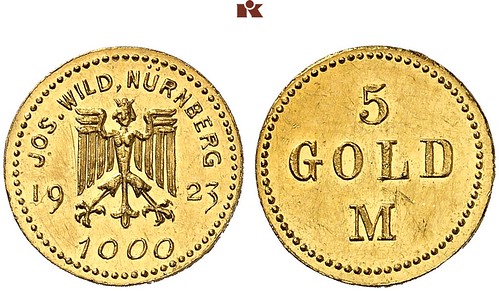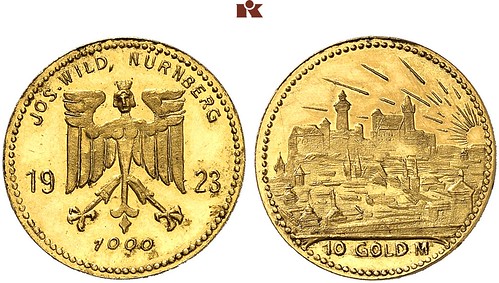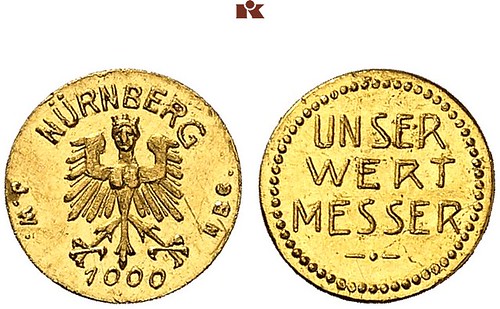
PREV ARTICLE
NEXT ARTICLE
FULL ISSUE
PREV FULL ISSUE
THE COINS OF JOSEF WILDThe Künker firm published an interesting article on the private gold coinage of Josef Wild. Here's an excerpt. -Editor

Josef Wild. 100 gold marks 1927.
On 15 March, 2019, the Osnabrück auction house Künker is auctioning off a collection which, until today, represents a highly sensitive issue from a monetary policy point of view. In the 1930s, Josef Wild attempted to return to the gold standard with private gold coins. The continuing topicality of his effort is illustrated by the fact that, in the late 1990s, Bernard von NotHaus did the same with the Liberty Dollar. Both men tried to supplement the official fiat currency at risk of inflation with a private gold coin of stable value. But let us start from the beginning. When the last Prussian 20-mark coin was struck at the Berlin mint in 1915, the hundredweight of subsidized potatoes cost 4.70 marks in the city of Münster. By 1918, the hungry Munster citizens paid 150 marks for a hundredweight of windfall apples on the black market. A pound of bacon cost 40 marks, a pound of butter 26. This is how the German (gold) mark decreased in value during the four years of the war, even though at first that was barely noticeable when looking at official prices and wages. And of course, the old gold coins had been completely vanished from circulation. The German currency which has become known as fiat money - a currency whose credentials are based on the reputation of the German state. 
Josef Wild. 5 gold marks 1923.
And in November of 1918, that reputation was not exactly at its highest. The Empire had 150 billion marks in debt. To put that into perspective: The entire national income in 1919 was estimated at 142 billion marks. On top of that, there were immense reparations to be paid. In order to be able to cover at least the domestic costs, the government started the money press. Which resulted in a huge decrease in value: If you had a nice 1,000 marks in August 1914, you were left with 10 marks in October 1921 - in terms of purchasing power -, and with 1 in October 1922. Thus, the assets had already melted away before the actual hyperinflation started, which made the price of a stamp soar from 15 pfennigs to one billion marks. The end of hyperinflation came with the German Rentenmark . On the 15th of October, 1923, the German Rentenbank was founded. Its assets were made unaffected by the inflation, which was mortgaged at a total of 3.2 billion bond markets . For the mortgage, the property owners have to pay interest. The magic trick worked: The bearer bonds circulating as banknotes were accepted by the entire population as secure currency. 
Josef Wild. 10 gold marks 1923.
Or let's say better, almost the entire population accepted them, because a small goldsmith in Nuremberg took up the fight against the new Fiat currency. We do not know too much about that Josef Wild, who did not want to know anything about the currency deals of the authorities. Most of the documents that could tell us more about his life have been burned during the Second World War. We know his date of birth, March 13, 1872. We are also told orally that he was short and stocky and in 1897 had passed the Master's examination as a master goldsmith. In addition we have a portrait, which he left for himself on his private 100 gold mark of 1927. Josef Wild grew up with the gold mark of the German Empire. He refused to accept the paper from the period of hyperinflation which was not replaced by a new gold currency, but another fiat money which was just as vulnerable to inflation. He demanded a currency of stable value. And since the German state did not provide any, he had minted at his own expense. 
Josef Wild. 1 gold mark without year (1923).
To read the complete article, see:

Wayne Homren, Editor The Numismatic Bibliomania Society is a non-profit organization promoting numismatic literature. See our web site at coinbooks.org. To submit items for publication in The E-Sylum, write to the Editor at this address: whomren@gmail.com To subscribe go to: https://my.binhost.com/lists/listinfo/esylum All Rights Reserved. NBS Home Page Contact the NBS webmaster 
|